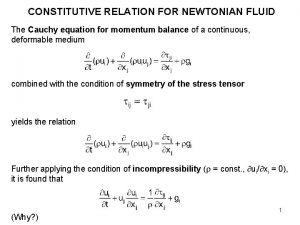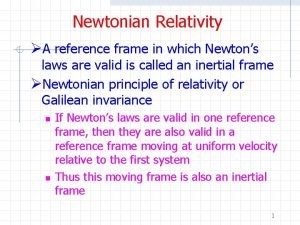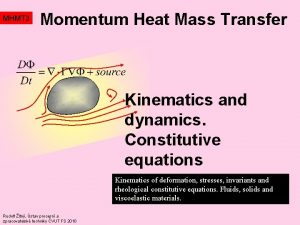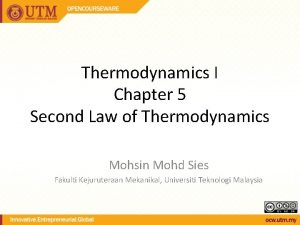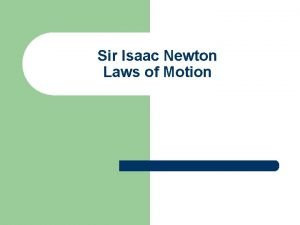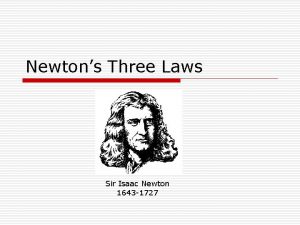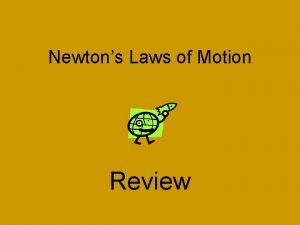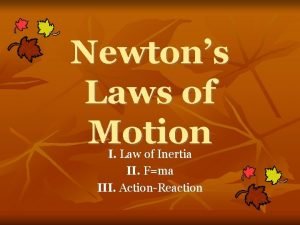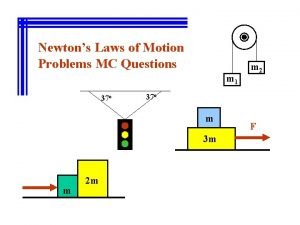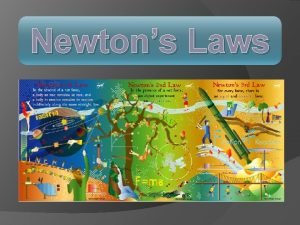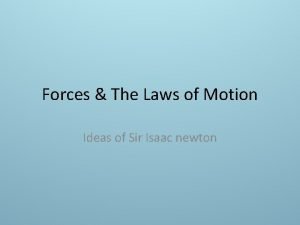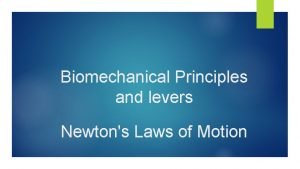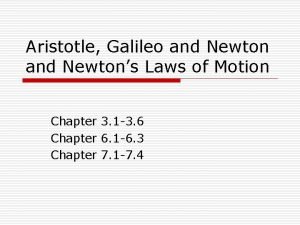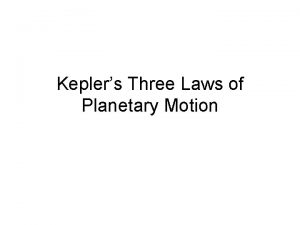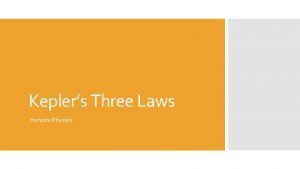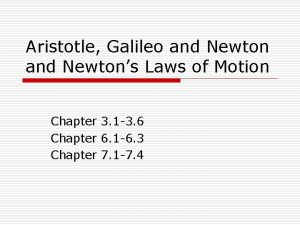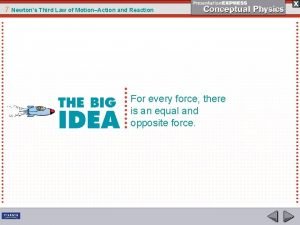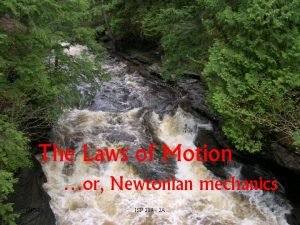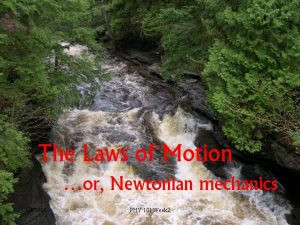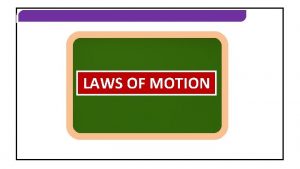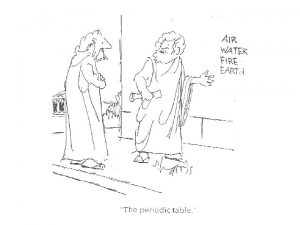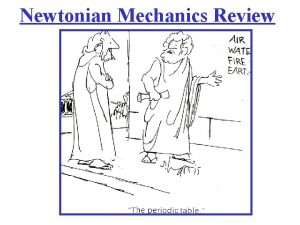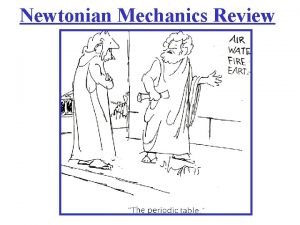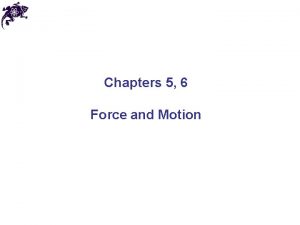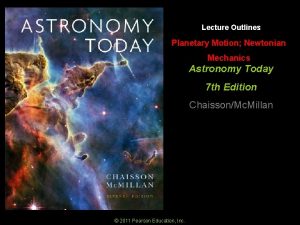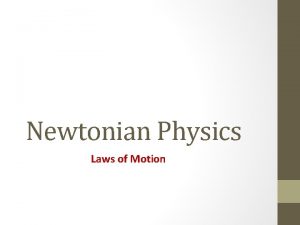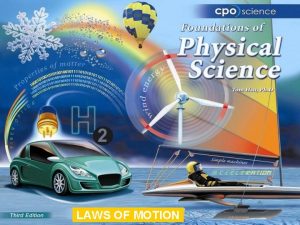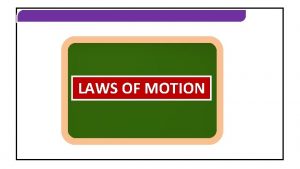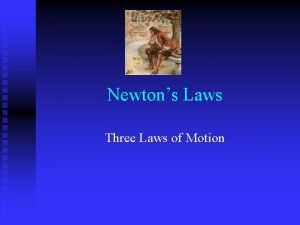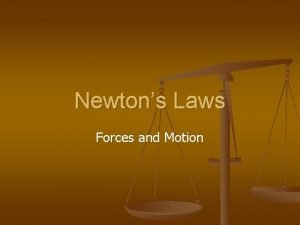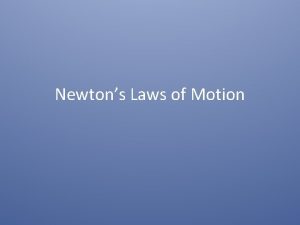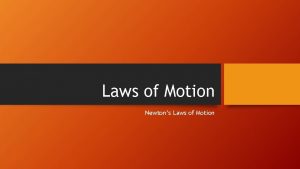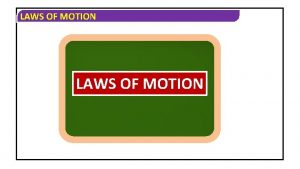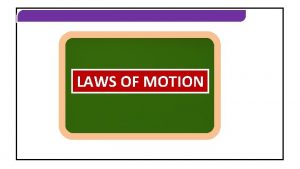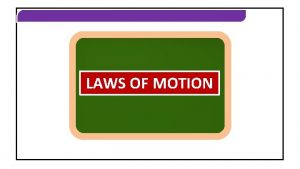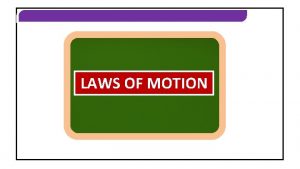Chapter 4 The Laws of Motion Newtonian mechanics
































- Slides: 32

Chapter 4 The Laws of Motion

Newtonian mechanics Sir Isaac Newton (1643 – 1727) • Describes motion and interaction of objects • Applicable for speeds much slower than the speed of light • Applicable on scales much greater than the atomic scale • Applicable for inertial reference frames – frames that don’t accelerate themselves

Force • What is a force? • Colloquial understanding of a force – a push or a pull • Forces can have different nature • Forces are vectors • Several forces can act on a single object at a time – they will add as vectors

Force superposition • Forces applied to the same object are adding as vectors – superposition • The net force – a vector sum of all the forces applied to the same object

Newton’s First Law • If the net force on the body is zero, the body’s acceleration is zero

Newton’s Second Law • If the net force on the body is not zero, the body’s acceleration is not zero • Acceleration of the body is directly proportional to the net force on the body • The coefficient of proportionality is equal to the mass (the amount of substance) of the object

Newton’s Second Law • SI unit of force kg*m/s 2 = N (Newton) • Newton’s Second Law can be applied to all the components separately • To solve problems with Newton’s Second Law we need to consider a free-body diagram • If the system consists of more than one body, only external forces acting on the system have to be considered • Forces acting between the bodies of the system are internal and are not considered

Chapter 4 Problem 12 Two forces are applied to a car in an effort to move it. (a) What is the resultant of these two forces? (b) If the car has a mass of 3 000 kg, what acceleration does it have? Ignore friction.

Newton’s Third Law • When two bodies interact with each other, they exert forces on each other • The forces that interacting bodies exert on each other, are equal in magnitude and opposite in direction

Forces of different origins • Gravitational force • Normal force • Tension force • Frictional force (friction) • Drag force • Spring force

Gravity force (a bit of Ch. 7) • Any two (or more) massive bodies attract each other • Gravitational force (Newton's law of gravitation) • Gravitational constant G = 6. 67*10 – 11 N*m 2/kg 2 = 6. 67*10 – 11 m 3/(kg*s 2) – universal constant

Gravity force at the surface of the Earth g = 9. 8 m/s 2

Gravity force at the surface of the Earth • The apple is attracted by the Earth • According to the Newton’s Third Law, the Earth should be attracted by the apple with the force of the same magnitude

Weight • Weight (W) of a body is a force that the body exerts on a support as a result of gravity pull from the Earth • Weight at the surface of the Earth: W = mg • While the mass of a body is a constant, the weight may change under different circumstances

Tension force • A weightless cord (string, rope, etc. ) attached to the object can pull the object • The force of the pull is tension ( T ) • The tension is pointing away from the body

Free-body diagrams

Normal force • When the body presses against the surface (support), the surface deforms and pushes on the body with a normal force (n) that is perpendicular to the surface • The nature of the normal force – reaction of the molecules and atoms to the deformation of material

Normal force • The normal force is not always equal to the gravitational force of the object

Free-body diagrams

Free-body diagrams

Chapter 4 Problem 30 An object with mass m 1 = 5. 00 kg rests on a frictionless horizontal table and is connected to a cable that passes over a pulley and is then fastened to a hanging object with mass m 2 = 10. 0 kg, as shown in the Figure. Find the acceleration of each object and the tension in the cable.

Frictional force • Friction ( f ) - resistance to the sliding attempt • Direction of friction – opposite to the direction of attempted sliding (along the surface) • The origin of friction – bonding between the sliding surfaces (microscopic cold-welding)

Static friction and kinetic friction • Moving an object: static friction vs. kinetic

Friction coefficient • Experiments show that friction is related to the magnitude of the normal force • Coefficient of static friction μs • Coefficient of kinetic friction μk • Values of the friction coefficients depend on the combination of surfaces in contact and their conditions (experimentally determined)

Free-body diagrams

Free-body diagrams

Chapter 4 Problem 49 Find the acceleration reached by each of the two objects shown in the figure if the coefficient of kinetic friction between the 7. 00 -kg object and the plane is 0. 250.

Answers to the even-numbered problems Chapter 4 Problem 2 25 N

Answers to the even-numbered problems Chapter 4 Problem 6 7. 4 min

Answers to the even-numbered problems Chapter 4 Problem 26 4. 43 m/s 2 up the incline, 53. 7 N

Answers to the even-numbered problems Chapter 4 Problem 40 (a) 55. 2°; (b) 167 N

Answers to the even-numbered problems Chapter 4 Problem 50 (a) 18. 5 N; (b) 25. 8 N
 Ft = mv - mu
Ft = mv - mu L
L Constitutive relation for newtonian fluid
Constitutive relation for newtonian fluid Teoria de la relatividad newton
Teoria de la relatividad newton Newtonian fluid formula
Newtonian fluid formula Modified newtonian dynamics
Modified newtonian dynamics Facts about montesquieu
Facts about montesquieu Chapter 2 section 1 describing motion answer key
Chapter 2 section 1 describing motion answer key The main difference between speed and velocity involves
The main difference between speed and velocity involves Section 1 describing motion worksheet answer key
Section 1 describing motion worksheet answer key Perpetual motion machine
Perpetual motion machine Isaac newton laws of motion
Isaac newton laws of motion What are newton's three laws of motion
What are newton's three laws of motion What are the 3 laws of motion
What are the 3 laws of motion 3 laws of motion by isaac newton
3 laws of motion by isaac newton Laws of motion
Laws of motion What are newton's 3 laws of motion in order
What are newton's 3 laws of motion in order Newton's laws of motion
Newton's laws of motion Laws of motion
Laws of motion Aristotle laws of motion
Aristotle laws of motion Newton's 3 laws
Newton's 3 laws Colin skateboards down the sidewalk
Colin skateboards down the sidewalk A person of weight 480 n stands
A person of weight 480 n stands What are newton's 3 laws
What are newton's 3 laws Who formulated the three laws of motion
Who formulated the three laws of motion Forces and the laws of motion problem b
Forces and the laws of motion problem b Brainpop newton's laws of motion worksheet answer key
Brainpop newton's laws of motion worksheet answer key Newton's second law example
Newton's second law example Law of inertia
Law of inertia Kepler's three laws of planetary motion
Kepler's three laws of planetary motion Keplers three laws
Keplers three laws Aristotle galileo and newton ideas about motion
Aristotle galileo and newton ideas about motion Newtons third law
Newtons third law


